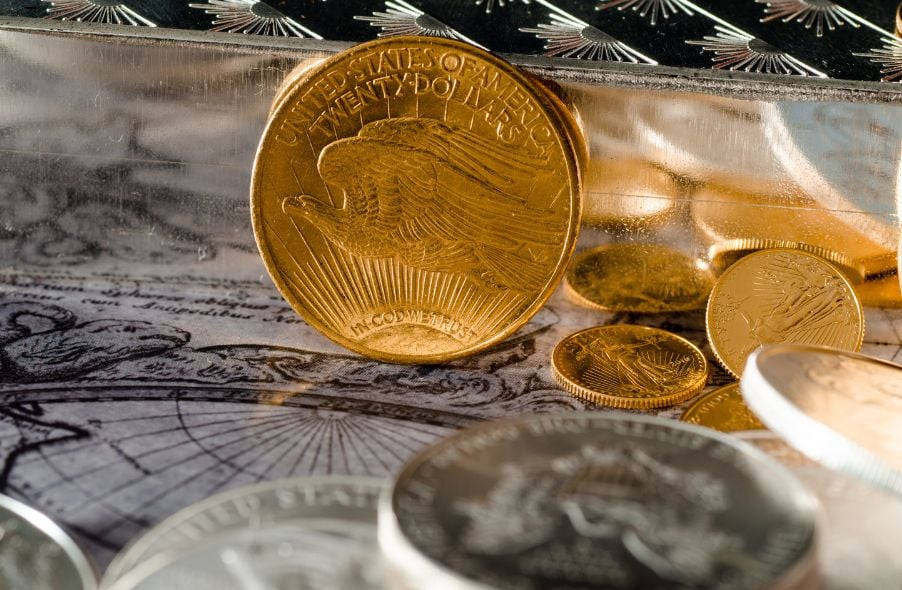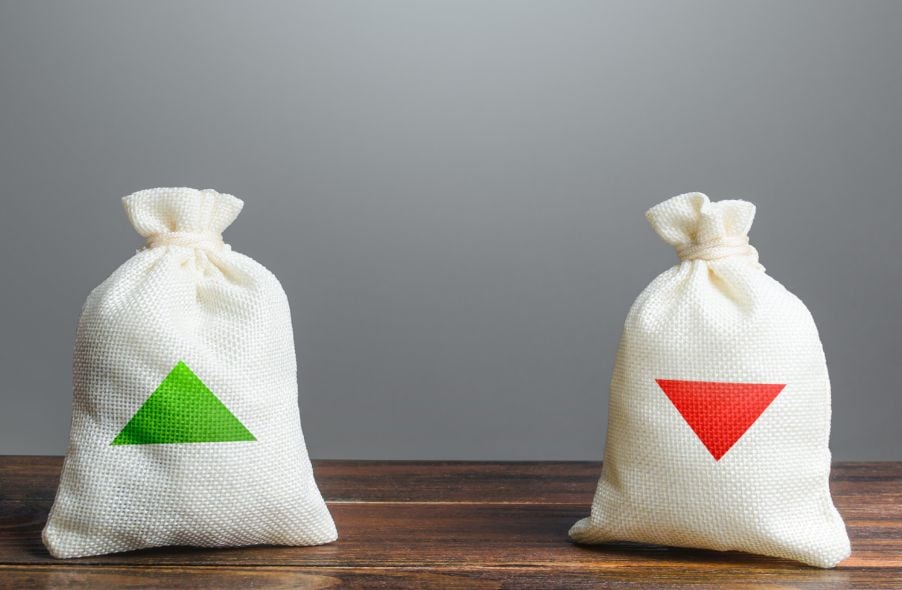Gold is a valuable asset — and not only for the reasons you might think. Of course, gold has value in itself. However, you can make the most of that value by investing it well. Investing in gold in an IRA has many benefits, including diversifying your portfolio and hedging against inflation.
The tricky thing is figuring out how you want to invest it. That is, choosing between a gold Roth IRA vs traditional gold IRA.
What Are the Differences Between Traditional and Roth IRAs?
Gold Roth IRAs and traditional gold IRAs are similar but vary in eligibility, contributions, taxation, and required minimum distributions.
Eligibility
Traditional IRAs have no income requirement. On the other hand, Roth IRAs have an income limit of $153,000 for individuals or $228,000 for married people filing jointly.
Your income will also determine how much of your contribution to your Roth IRA you can deduct from your annual taxes.
Contributions
How you contribute to each of these IRA types also differs. Roth IRAs are self-directed, while traditional IRAs give you less power over investment decisions. For both IRAs, you can open an account and store your gold in any IRS-approved depository, but the IRS taxes contributions to Roth IRAs at the time you make the contribution. With a traditional IRA, you don't pay taxes on contributions.
Taxation
Each IRA type has different tax advantages and drawbacks. Contributions to traditional IRAs are tax-free, while contributions to Roth IRAs are not. It's the opposite case for IRA withdrawals: You'll pay taxes on traditional IRA withdrawals but not on Roth IRA withdrawals since you pay taxes on the contribution when you invest the funds in your account.
If you're a low- or moderate-income investor, you might be eligible for a tax break when you contribute to either IRA account. This is called the Saver's Credit and can earn you up to $2,000, depending on the amount you contribute.
Required Minimum Distribution
Finally, a gold Roth IRA vs traditional gold IRA differs because of their required minimum distributions. Traditional IRAs require you to start making minimum distributions from your account starting at age 72, while Roth IRAs don't require a minimum distribution at all.
Are There Similarities Between Traditional and Roth IRAs?

Despite the differences, traditional and Roth gold IRAs share similarities relating to what metals you can invest in, where you store those precious metals, how much you can contribute to the IRA each year, and restrictions on withdrawals.
Precious Metal Investment
These retirement accounts allow for precious metal investments in physical assets like gold and silver. While inflation may make stocks risky and unreliable investments, gold prices and value are consistent and more secure over the long term. Whether you're contributing gold jewelry, coins, or bars, precious metal IRAs help you use that value to its full advantage.
Custodian Requirement
Regardless of whether you choose a traditional or Roth IRA, you will need a custodian. A custodian is a qualified professional who has been approved by the government to manage your IRA account and assets. The custodian also stores your physical gold assets and reports them to the IRS. For your custodian, you may appoint:
- Brokerage firm
- Gold IRA company
- Trust company
- Credit union
- Bank
Contribution Limit

Both traditional gold and gold Roth IRA types have the same contribution limit. A contribution limit refers to the dollar amount you can contribute to an IRA account annually. While this changes year-to-year, for the 2023 tax year, that limit is $6,500. People aged 50 or older may contribute up to $7,500 a year. If you have more than one IRA, this is the amount you may contribute to all your accounts in total.
There is no age maximum or minimum when contributing to an IRA. You can begin contributing as early as you want and continue contributing well into retirement.
Prohibited Transactions and Early Withdrawal Penalties
While you can contribute to your gold IRA as early as you want, you have to hold off on withdrawing funds. Withdrawing any funds from your IRA before you're 59.5 years old will come with a 10% penalty.
Additionally, though Roth IRA withdrawals are usually taxable, withdrawing too early means the withdrawn funds might contribute to your taxable income. Roth IRAs also require that you've had the account for at least five years before making a withdrawal.
Available Options for Gold Investment Within an IRA
You have a variety of options for gold investment in both gold Roth IRAs and gold traditional IRAs. You may invest:
- Physical gold (gold bars, jewelry, coins)
- ETFs (exchange-traded funds)
- Gold mining stocks
- Mutual funds
- Gold certificates
Each of these represents a different form or conversion of gold. You can stick to one form of investment or further diversify your portfolio by exploring multiple options.
Advantages and Disadvantages of a Gold Roth IRA vs Traditional Gold IRA

Each IRA type comes with advantages and disadvantages.
A Gold Roth IRA:
- Avoids taxes in retirement
- Builds wealth in the long run
- Has fewer distribution restrictions
- Is helpful for estate planning
But it also…
- Taxes your contributions
- Has income requirements
Meanwhile, a traditional gold IRA:
- Lowers your taxable income every year
- Comes with an earlier tax break
- Has no income requirement
- Is helpful for estate planning
But it also…
- Is more costly in retirement
- Often means less savings in the long run
Factors to Consider in Choosing Between IRA Types

Let's narrow down what really matters when making the decision between a gold Roth IRA vs traditional gold IRA.
Current and Future Tax Considerations
Now that you know the implications of each IRA type in terms of taxation, you can consider what the best option for you is. If you'd rather be taxed on your contributions, consider a gold Roth IRA. If you prefer to pay taxes on your withdrawals during retirement, a traditional IRA might be best for you.
Personal Financial Goals and Retirement Plans
Due to the tax implications of each IRA, the best way to choose a type is to consider your retirement plan's expectations. If you plan to be in a higher tax bracket in retirement, you should consider a Roth IRA so you can pay taxes now at a lower rate. The opposite is true for a traditional IRA. If you expect to be in the same or a lower tax bracket in retirement, a traditional IRA would allow you to pay taxes at that rate in the future.
Risk Tolerance and Investment Timeline
Before you commit to either type of IRA, you should be aware of the risks you face with any gold IRA. Since these are long-term investments, you won't have immediate access to your precious metals.
Risks come with any market, and the value of precious metals may fluctuate over time. You should also keep an eye out for scams. Doing your research and never rushing into decisions can help you avoid fraudulent scammers and disreputable custodians. There are also several gold IRA fees that you should anticipate: custodian fees, storage fees, and selling fees.
Consult With Professionals
Doing your own research prepares you to decide, but consulting with a financial advisor helps you solidify the decision between a gold Roth IRA vs traditional gold IRA.
To maximize the value of your investments, partner with the best gold IRA company for you with Learn About Gold.
Frequently Asked Questions
Are You Ready to Invest in Gold?
The answer depends on how much money you have saved and whether gold was an investment option available when you started saving. Consider investing in both.
Not only is it a safe investment but gold can also provide potential returns. Retirement investors will find gold a worthy investment.
Gold is more volatile than most other investments. Its value fluctuates over time.
This does not mean you shouldn’t invest in gold. Instead, it just means you should factor the fluctuations into your overall portfolio.
Another advantage of gold is its tangible nature. Unlike stocks and bonds, gold is easier to store. It's also portable.
You can always access gold as long your place it safe. Additionally, physical gold does not require storage fees.
Investing in gold can help protect against inflation. Because gold prices tend to rise along with other commodities, it's a good way to hedge against rising costs.
Also, you'll reap the benefits of having some savings invested in something with a stable value. Gold rises in the face of a falling stock market.
You can also sell gold anytime you like by investing in it. Just like stocks, you can liquidate your position whenever you need cash. You don't even need to wait for your retirement.
If you do decide to invest in gold, make sure to diversify your holdings. Do not put all your eggs in one basket.
You shouldn't buy too little at once. Begin by buying a few grams. Continue adding more as necessary.
Don't expect to be rich overnight. Instead, the goal here is to build enough wealth to not need to rely upon Social Security benefits.
Although gold might not be the right investment for everyone it could make a great addition in any retirement plan.
What Does Gold Do as an Investment Option?
The supply and demand for gold affect the price of gold. Interest rates also have an impact on the price of gold.
Gold prices are volatile due to their limited supply. In addition, there is a risk associated with owning physical gold because you have to store it somewhere.
Should You Buy Gold?
Gold was a safe investment option for those who were in financial turmoil. Today, many people are looking to precious metals like gold and avoiding traditional investments like bonds and stocks.
The trend for gold prices has been upward in recent years but they still remain low relative to other commodities like silver and oil.
This could be changing, according to some experts. Experts predict that gold prices will rise sharply in the wake of another global financial collapse.
They also pointed out that gold is gaining popularity due to its perceived value, and potential return.
These are some important things to remember if your goal is to invest in gold.
- Before you start saving money for retirement, think about whether you really need it. You can save for retirement and not invest your savings in gold. Gold does offer an extra layer of protection for those who reach retirement age.
- You should also be aware of what you are getting into before you buy gold. There are many types of gold IRA accounts. Each offer varying degrees of security and flexibility.
- Last but not least, gold doesn't provide the same level security as a savings account. It is possible to lose your gold coins.
You should do your research before buying gold. If you already have gold, make sure you protect it.
Can I buy gold with my self-directed IRA?
However, gold can only be purchased with your self-directed IRA. To do so, you must first open a brokerage account at TD Ameritrade. You can also transfer funds from an existing retirement fund.
Individuals can contribute as much as $5,500 per year ($6,500 if married filing jointly) to a traditional IRA. Individuals can contribute as much as $1,000 per year ($2,000 if married filing jointly) to a Roth IRA.
You should consider buying physical gold bullion if you decide to invest in it. Futures contracts, which are financial instruments based upon the price of gold, are financial instruments. You can speculate on future prices, but not own the metal. You can only hold physical bullion, which is real silver and gold bars.
How to Open a Precious Metal IRA
First, you must decide if your Individual Retirement Account (IRA) is what you want. Open the account by filling out Form 8606. You will then need to complete Form 5204 in order to determine which type IRA you are eligible. You must complete this form within 60 days of opening your account. Once this has been completed, you can begin investing. You can also contribute directly to your paycheck via payroll deduction.
Complete Form 8903 if your Roth IRA option is chosen. Otherwise, the process will look identical to an existing IRA.
To qualify for a precious-metals IRA, you'll need to meet some requirements. You must be at least 18 years of age and have earned income to qualify for a precious metals IRA. For any tax year, your earnings must not exceed $110,000 ($220,000 for married filing jointly). And, you have to make contributions regularly. These rules apply to contributions made directly or through employer sponsorship.
A precious metals IRA can be used to invest in palladium or platinum, gold, silver, palladium or rhodium. But, you'll only be able to purchase physical bullion. You won't have the ability to trade stocks or bonds.
Your precious metals IRA can be used to directly invest in precious metals-related companies. This option can be provided by some IRA companies.
There are two major drawbacks to investing via an IRA in precious metals. First, they're not as liquid as stocks or bonds. This makes them harder to sell when needed. Second, they don't generate dividends like stocks and bonds. So, you'll lose money over time rather than gain it.
What precious metals can you invest in for retirement?
Silver and gold are two of the most valuable precious metals. They are both simple to purchase and sell, and they have been around for a long time. You should add them to your portfolio if you are looking to diversify.
Gold: This is the oldest form of currency that man has ever known. It is stable and very secure. Because of this, it's considered a good way to preserve wealth during times of uncertainty.
Silver: Investors have always loved silver. It's a good choice for those who want to avoid volatility. Unlike gold, silver tends to go up instead of down.
Platinium: Another form of precious metal is platinum, which is becoming more popular. It is very durable and resistant against corrosion, much like silver and gold. However, it's much more expensive than either of its counterparts.
Rhodium: Rhodium is used in catalytic converters. It is also used to make jewelry. And, it's relatively cheap compared to other types of precious metals.
Palladium: Palladium is similar to platinum, but it's less rare. It's also less expensive. For these reasons, it's become a favorite among investors looking to add precious metals to their portfolios.
Who holds the gold in a gold IRA?
An individual who has gold is considered to be a “form of money” by the IRS and subject to taxation.
You must have gold at least $10,000 and it must be stored for at the least five years in order to take advantage of this tax-free status.
The purchase of gold can protect you from inflation and price volatility. But it's not smart to hold it if your only intention is to use it.
If you plan to eventually sell the gold, you'll need a report on its value. This could impact the amount of capital gains taxes your owe if you cash in your investments.
To find out what options you have, consult an accountant or financial planner.
Statistics
- Gold is considered a collectible, and profits from a sale are taxed at a maximum rate of 28 percent. (aarp.org)
- Indeed, several financial advisers interviewed for this article suggest you invest 5 to 15 percent of your portfolio in gold, just in case. (aarp.org)
- If you accidentally make an improper transaction, the IRS will disallow it and count it as a withdrawal, so you would owe income tax on the item's value and, if you are younger than 59 ½, an additional 10% early withdrawal penalty. (forbes.com)
- If you take distributions before hitting 59.5, you'll owe a 10% penalty on the amount withdrawn. (lendedu.com)
- The price of gold jumped 131 percent from late 2007 to September 2011, when it hit a high of $1,921 an ounce, according to the World Gold Council. (aarp.org)
External Links
wsj.com
- Saddam Hussein's InvasionHelped Uncage a Bear in 1990 – WSJ
- Want to Keep Gold in Your IRA at Home? It's Not Exactly Lawful – WSJ
bbb.org
law.cornell.edu
- 7 U.S. Code SS 7 – Designation of boards of trade as contract markets
- 26 U.S. Code SS 408 – Individual retirement accounts
irs.gov
How To
How to keep physical gold in an IRA
An easy way to invest gold is to buy shares from gold-producing companies. This method is not without risks. There's no guarantee these companies will survive. Even if they survive, there's always the risk that they will lose money due fluctuations in gold prices.
Another option is to purchase physical gold. You'll need to open a bank account, buy gold online from a trusted seller, or open an online bullion trading account. The advantages of this option include the ease of access (you don't need to deal with stock exchanges) and the ability to make purchases when prices are low. It's also easier to see how much gold you've got stored. You will receive a receipt detailing exactly what you paid. You have less risk of theft when investing in stocks.
There are also some drawbacks. For example, you won't benefit from banks' interest rates or investment funds. Additionally, you won’t be able diversify your holdings. You will remain with the same items you bought. Finally, the taxman might want to know where your gold has been placed!
If you'd like to learn more about buying gold in an IRA, visit the website of BullionVault.com today!
—————————————————————————————————————————————————————————————-
By: Learn About Gold
Title: Gold Roth IRA vs Traditional Gold IRA: The Main Differences
Sourced From: learnaboutgold.com/blog/gold-roth-ira-vs-traditional-gold-ira/?utm_source=rss&utm_medium=rss&utm_campaign=gold-roth-ira-vs-traditional-gold-ira
Published Date: Wed, 26 Jul 2023 18:58:46 +0000













